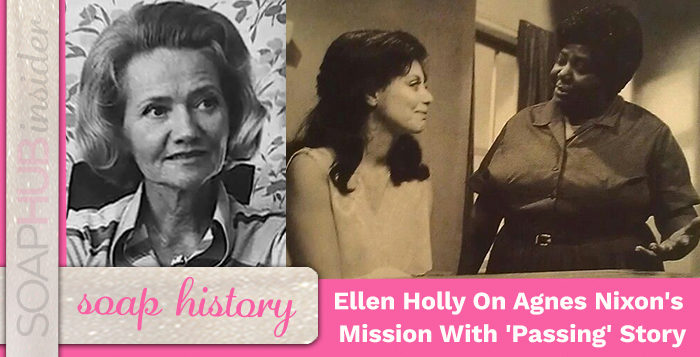
Video Credit: Soap Hub
In 1968, One Life to Live forced its viewers to examine their prejudices by presenting a daring and revolutionary story. Carla Benari, a white woman who was dating a white man, also found herself attracted to a black doctor. This scenario alone was a breakthrough in daytime racial portrayals, but what the audience didn’t know, until it was revealed in later episodes, was that Carla was actually Clara Gray, a black woman passing for white.
One Life To Live — Reflecting The Times
Show creator and writer Agnes Nixon used the Carla Gray storyline to bring people face to face with their own prejudices.
“Agnes wanted to take the viewers and have them become involved with a character believing that character to be one thing,” says Carla’s portrayer, actress Ellen Holly. That way, when the character’s true identity was revealed, if a viewer’s feelings about her changed, “then the viewer would have her eyes opened up as to how she must be prejudiced.”
From the beginning, Nixon was interested in telling the story as accurately as possible. “When the part first became available, all of the agents in town sent white actresses because they assumed that the show was going to do what had been done historically and that a white actress was going to play the part,” explains Holly.
“Doris Quinlan, who was the producer at the time, and Agnes Nixon informed the agents ‘This is a black role. We want a black actress to play it.’ So the casting started all over again,” revealed Holly.
During this process, Nixon saw a picture of Holly in the New York Times and knew that she had found the right actress for the part. For Holly, a veteran of the theater, the role was a rare luxury.
“Because of what I looked like, I always had to wear dark makeup to be allowed to play black parts,” says the actress, who is proud of her heritage. “This was the one black part that I was able to play with my own face.”
In addition, she was given a chance to have input into the story. “When I initially got the part, Agnes had me come up to her house and we talked at great lengths. Wonderful writer that she was, she was smart enough to know that, as a white person, she did not know all that much about the black world and how it functioned.
“So we sat down and we had a full out conversation about a whole lot of things…the psychology of certain people, why they would do such a thing, what the pressures are, and so on. So it became something of a collaboration.”
A Collaborative Effort
That collaboration proved fruitful, as the One Life to Live audience was fascinated by the story and by the characters involved in it.
“Black people do pass for white. It is a sociological reality. It is a truth, and anything that is a truth is worth examining, as long as you really examine it – and that is what the show did. It examined the whole dynamic of why it happens and how it happens.
“It made the point that people do not pass for white because they want to be white, but because they want all of the perks and privileges that accrue to whiteness in this society – there is a difference,” remarked Holly.
“It went into all the psychology and the complexities and the permutations of passing and how it affects the dynamic between you and the people to whom you are connected when you pass and they don’t. It didn’t just use it as a dramatic plotline. It examined it in detail, so I thought it was a marvelous story, and valuable on those terms.”
Although the actors in the storyline were not the first black performers signed to soap opera contracts, their characters were the first-ever conceived on the drawing board as black characters with plotlines that related to what black people experience. That fact alone made the storyline a groundbreaking one according to Holly.
“The portrayals of black women are so profoundly limited and have so very little to do with who black women really are. Black women are so fascinating and so complicated, and the variety is so tremendous that it’s almost a crime to see the limited framework in which black female roles are written.
“Because it is so limited,” Holly continued, “to the extent that you transcend, even marginally, the limitations, progress is made. And I certainly feel that the roles that Lillian Hayman [Carla’s mother, Sadie] and I played went beyond the sort of stereotype roles that were usually available to us.”
Holly credits ABC with the courage to do the storyline without knowing how it was going to be received.
“They hedged their bets by signing us to the shortest contracts of any of the performers on the show. Other people were signed to two or three-year contracts. We were all signed to one-year contracts. They just didn’t know. Well, it played so marvelously that we were there for a long, long time.”
In fact, the storyline paved the way for other shows to add black stories to their canvases.
“Because it was so successful on One Life To Live, ABC had considerably less concern when Agnes wanted to introduce a black storyline on All My Children,” says Holly. “And they also started using blacks on General Hospital, too. The other networks eventually came aboard, so now black storylines are used throughout the soap opera genre.”
